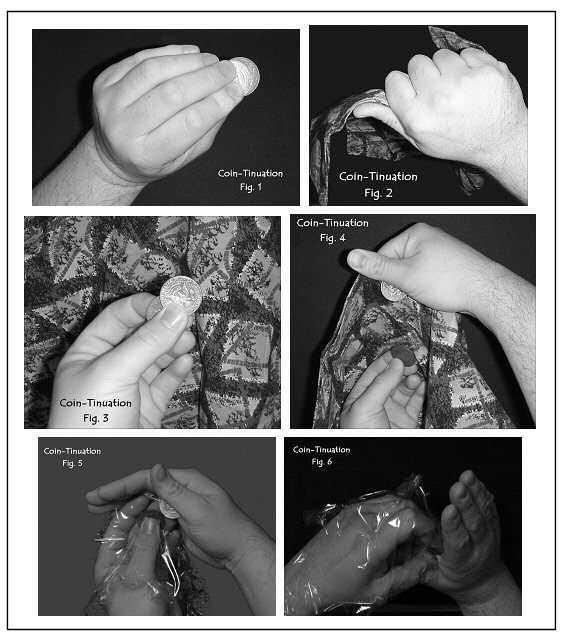Coin-Tinuation
Effect:
Two coins penetrate a solid handkerchief.
Note:
This effect is a perfect follow up to David Winkler’s Penetrating Transfer aka Coin Flakes. At the end of Penetrating Transfer, you are left with two contrasting coins and a handkerchief. Oh by the way, these two effects work much better with a dinner napkin not a silk. This effect, Coin-Tinuation, is also the creation of David Winkler, and is beautiful in the hands of a coin worker like David.
Performance:
This is a Winkler variation of an old move: Hold the two contrasting coins at the finger tips in the left hand (see fig. 1). Pick up the hank with the right hand. Grip one edge of the hank with the right thumb on your side and the fingers on the audience side. You’ll sort of be making a fist with your right hand through the hank (see fig. 2).
You are going to cover the coins with the hank. As soon as the coins are out of view, use your left thumb to up jog the coin nearest you (see fig. 3). As the hank is moved toward your body, use your right hand to steal the up jogged coin (see fig. 4).
Continue moving the hank up your forearm to cover the remaining coin. As you do this, you must get the stolen coin into the thumb palm position. This is not as easy as it sounds. Sometimes the hank gets in the way. Just a little practice will fix this problem. This next move is very easy to do. It’s just difficult to explain.
You are going to apparently try to pull one coin through the hank and fail. Actually what you do is this: With the right hand coin thumb palmed, reach over to the left hand, with the right fingers in front of the left fingers and the right thumb behind the left fingers (see fig. 5). Place the palmed coin right back where it was before you stole it. Only this time it’s on the outside of the hank. NOW, LISTEN CAREFULLY! Your left thumb will press the back of the coin and your left fingers will press the front of the coin. Allow the fleshy part of your right hand that is between the thumb and index finger to be pinched between the left hand fingers and the coin (see fig. 6).
This is very strange and difficult to describe in print. It’s also difficult to photograph. If you look closely at the crotch of the right thumb in figure six, you will see the coin and the finger pinching the right thumb crotch. However, the angle you see in figure six is not correct; it was just easier to photograph this angle. In reality, your hands are still held in the same position as figure five, but now the right hand is being pinched as shown in figure six. Remember, this all happens with your left hand covered, holding one coin, and the right hand uncovered, with a coin outside the hank. This whole sequence only takes a nano-second.
Now sharply pull your right hand away, and close it into a fist as if you have grabbed the coin. The pressure of your left thumb and fingers will cause the coins to snap together. If you do it correctly, it will hurt your thumb crotch a little bit. Between the closed fist and the click sound they will think you have the coin. Remember this whole sequence of events happens quickly, in one smooth motion, as if you are reaching over to pluck out the coin.
Next open your right hand, as if to show the coin. Then act surprised when you see that it isn’t there. Now, use your right hand to pull the front of the hank down toward the floor. This will force the coin upward, and it appears as if it penetrates the hank (see fig. 7). The situation now is that your left hand is palm up, pinching the two coins together, one on the outside and one on the inside of the hank.
Remove the coin that has penetrated the hank, and place it on the table. Do not let go of the cloth that is pinched between your left thumb and the coin that’s under the handkerchief. This is the set up for the next penetration.
This is an old move, but for the new and unfamiliar, we will describe it again. Using the right hand, lift up the front of the hank, and lay it on your left forearm, displaying the remaining coin (see fig. 8).
Next twist your left forearm to the right so that your left fingers and thumb are pointing to the floor. Now the coin should be behind and outside of the hank (see fig. 9). You can see the coin, but the audience cannot. While holding the coin in place, twist the hank below the coin. It looks as though you are securing the coin in the hank. Keep twisting until the coin starts to show. It will appear to have penetrated the hank (see fig. 10). This is a very visual penetration of a coin.


